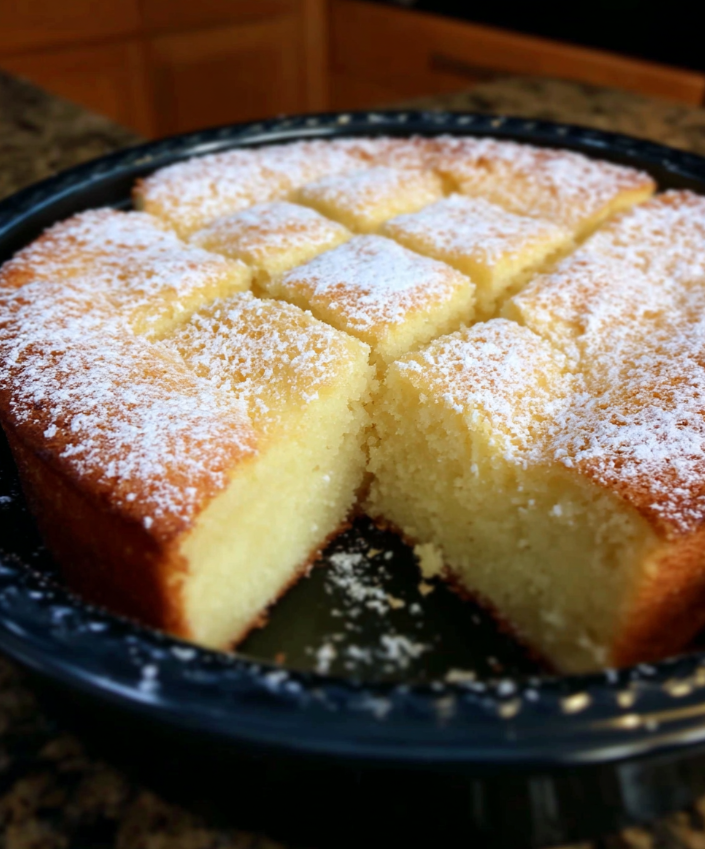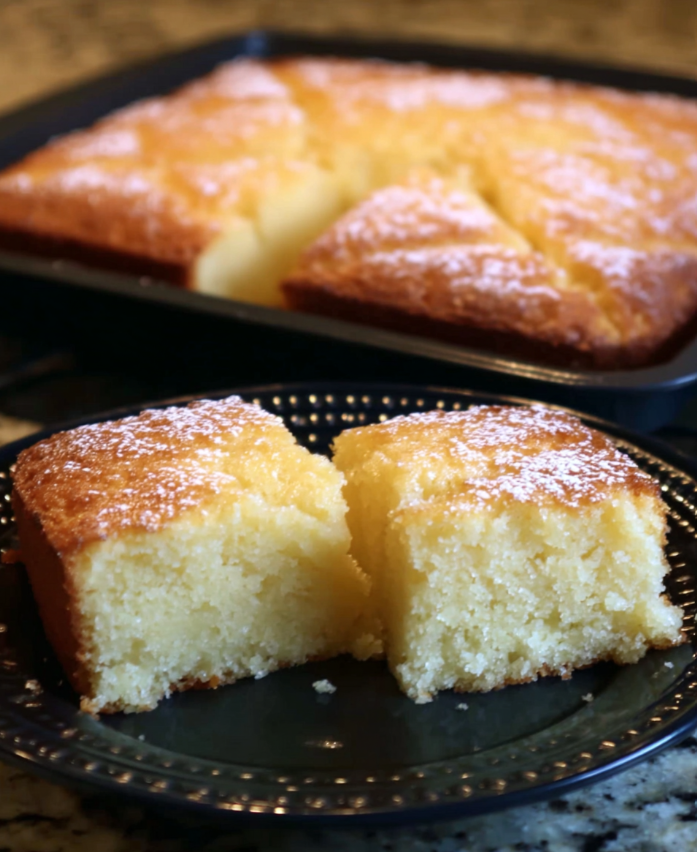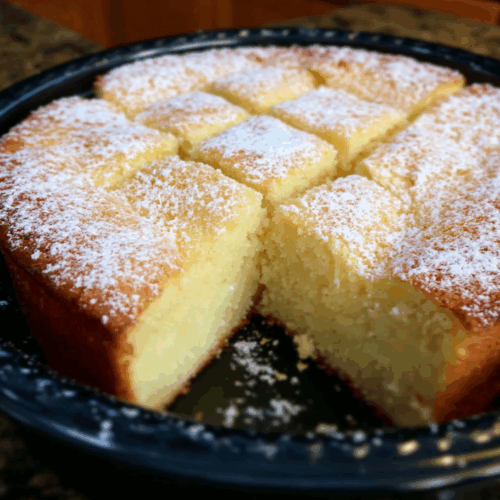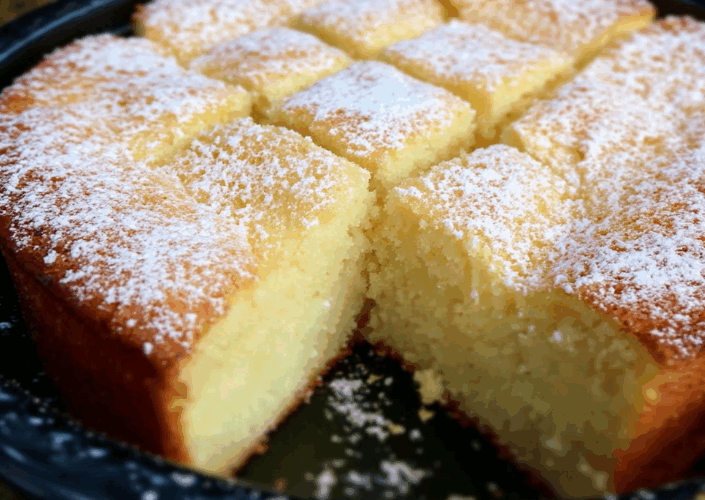There’s something timeless about a French butter cake. It’s not loud or showy like frosted layer cakes, instead, it’s that quiet kind of indulgence that wins you over one bite at a time. Soft, buttery, and fragrant with vanilla, it captures the essence of simple French baking: restraint, balance, and elegance.
If you’ve been craving a dessert that’s easy to make yet feels luxurious, this French Butter Cake Recipe might be the one you’ve been missing. It’s ideal for beginner bakers (no complicated steps) and deeply satisfying for anyone who appreciates the art of baking from scratch. Serve it as a weekend treat, an afternoon pick-me-up, or a centerpiece for brunch — it fits every mood and moment.

Ingredients for Authentic French Butter Cake
- 1 cup (2 sticks) unsalted butter, softened
- 1 ½ cups granulated sugar
- 4 large eggs, room temperature
- 2 teaspoons pure vanilla extract
- 2 cups all-purpose flour
- 1 teaspoon baking powder
- ½ teaspoon salt
- ½ cup whole milk or heavy cream
Optional finishing touches:
- Powdered sugar for dusting
- Fresh berries or whipped cream for serving
Baker’s Note: Use European-style butter for a richer flavor, and always bring ingredients to room temperature before mixing — it makes a world of difference.
Step-by-Step Instructions (Classic French Method)
- Preheat the oven to 350°F (175°C). Grease a 9-inch round or springform cake pan, then line the bottom with parchment paper for easy release.
- Cream the butter and sugar together in a large bowl using a stand mixer or hand mixer. Beat for about 3–5 minutes until pale, fluffy, and airy — this step defines your cake’s texture.
- Add the eggs one at a time, beating well after each addition to maintain a smooth batter.
- Mix in the vanilla extract until fully combined.
- In a separate bowl, whisk the flour, baking powder, and salt together.
- Gradually add the dry ingredients to the wet mixture on low speed, alternating with milk or cream, until just combined. Avoid overmixing — the batter should feel silky and thick.
- Pour the batter into your prepared pan, smoothing the top with a spatula.
- Bake for 40–50 minutes, until the top turns golden and a toothpick inserted in the center comes out with a few moist crumbs.
- Cool the cake in the pan for 10–15 minutes, then transfer to a wire rack to cool completely.
- Dust with powdered sugar or serve plain to enjoy its pure buttery flavor.

Tips & Tricks for the Best Texture and Flavor
- Use room-temperature ingredients for even mixing.
- Don’t overmix once the flour goes in — it keeps the crumb tender.
- Test for doneness early (around 40 minutes). Ovens vary.
- For a bakery-style crust, lightly brush melted butter on top right after baking.
- This cake actually tastes even better the next day, once flavors meld.
French Butter Cake vs. Italian Butter Cake
| Feature | French Butter Cake | Italian Butter Cake |
|---|---|---|
| Sweetness | Mild, buttery | Sweeter, often syruped |
| Texture | Dense yet tender | Fluffier, layered |
| Flavor Notes | Pure butter and vanilla | Citrus, almond, or liqueur |
| Presentation | Simple, rustic | Decorative, festive |
In essence, the French version focuses on texture and subtlety — an ode to balance — while the Italian variant celebrates richness and celebration. Both delicious, but French butter cake feels effortlessly chic.
Substitutions & Variations
- Gluten-Free: Use a 1:1 gluten-free flour blend (texture will be slightly softer).
- Dairy-Free: Substitute butter with plant-based alternatives like Miyoko’s or Flora unsalted block.
- Flavor Twists: Add 1 teaspoon of almond extract or a tablespoon of citrus zest.
- Vegan Version: Replace each egg with ¼ cup of applesauce or aquafaba (note: texture will differ).
Serving & Presentation Ideas
- Serve warm with berries and crème fraîche.
- Slice thin and toast lightly for a buttery breakfast treat.
- Pair with espresso or tea for a French café vibe.
- For holidays, top with candied orange peel or spiced syrup.
Presentation Tip: Dust powdered sugar through a lace doily for a Parisian-style pattern.
How to Store & Freeze French Butter Cake
- At room temperature: Store covered for up to 3 days.
- Refrigerate: Wrap tightly and chill up to 1 week.
- Freeze: Slice, wrap each piece in plastic and foil, and freeze for up to 3 months.
- To reheat: Warm gently in a 300°F (150°C) oven for 5–7 minutes, wrapped in foil to restore moisture.
Frequently Asked Questions (FAQ)
Can I use salted butter instead of unsalted?
Yes, just reduce the added salt by about half. The flavor will be slightly deeper and more caramelized.
Can I bake this in a loaf pan?
Absolutely! Bake at the same temperature for about 55–60 minutes.
Can I make this ahead of time?
Yes, in fact it improves overnight as the crumb softens and flavors deepen.
Why does my cake sink in the middle?
Usually due to underbaking or overmixing. Ensure the center is fully set before removing it from the oven.
Nutrition Information (per slice)
| Nutrient | Amount |
|---|---|
| Calories | ~370 kcal |
| Total Fat | 22 g |
| Saturated Fat | 13 g |
| Carbohydrates | 38 g |
| Protein | 5 g |
| Sugar | 24 g |
(Values are approximate and vary with ingredient brands.)
A Slice of French Simplicity
This French Butter Cake Recipe is a reminder that sometimes the simplest desserts hold the most magic. With nothing but butter, eggs, sugar, and flour, you get a cake that feels both humble and exquisite, the kind of recipe that finds its way into family traditions.
So bake it once, let it cool, and share it warm. You’ll see why generations of French bakers have kept this classic close to heart, it’s comfort and elegance in one golden slice.

Perfect French Butter Cake Recipe
Ingredients
- 1 cup (2 sticks) unsalted butter, softened
- ½ cups granulated sugar
- 4 large eggs, room temperature
- 2 tsp pure vanilla extract
- 2 cups all-purpose flour
- 1 tsp baking powder
- ½ tsp salt
- ½ cup whole milk or heavy cream
Optional finishing touches:
- Powdered sugar for dusting
- Fresh berries or whipped cream for serving
Instructions
- Preheat the oven to 350°F (175°C). Grease a 9-inch round or springform cake pan, then line the bottom with parchment paper for easy release.
- Cream the butter and sugar together in a large bowl using a stand mixer or hand mixer. Beat for about 3–5 minutes until pale, fluffy, and airy — this step defines your cake’s texture.
- Add the eggs one at a time, beating well after each addition to maintain a smooth batter.
- Mix in the vanilla extract until fully combined.
- In a separate bowl, whisk the flour, baking powder, and salt together.
- Gradually add the dry ingredients to the wet mixture on low speed, alternating with milk or cream, until just combined. Avoid overmixing — the batter should feel silky and thick.
- Pour the batter into your prepared pan, smoothing the top with a spatula.
- Bake for 40–50 minutes, until the top turns golden and a toothpick inserted in the center comes out with a few moist crumbs.
- Cool the cake in the pan for 10–15 minutes, then transfer to a wire rack to cool completely.
- Dust with powdered sugar or serve plain to enjoy its pure buttery flavor.
Notes
- Baker’s Note: Use European-style butter for a richer flavor, and always bring ingredients to room temperature before mixing — it makes a world of difference.

